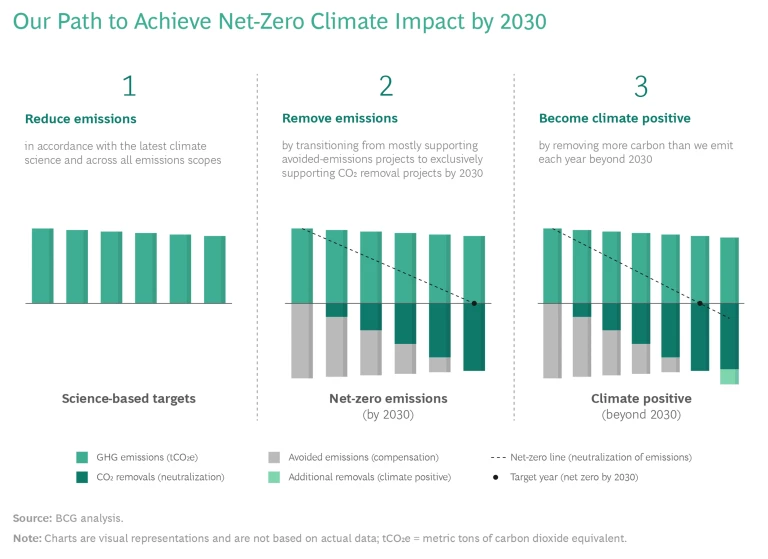The climate actions we’ve taken so far, the lessons we’ve learned—and a new target aimed at cutting our emissions intensity in half by 2025.
One year ago, in a landmark moment in BCG’s history, we announced a bold new commitment to achieve net-zero climate impact by 2030 and, from there, to become climate positive, removing more carbon from the atmosphere than we emit each year. (See the exhibit.)
Since our announcement, there has been important progress toward climate goals and the development of standardized net-zero guidance. For example, the Science Based Targets initiative (SBTi) is playing an important role in defining criteria for assessing net-zero targets, and many other companies have come out and announced net-zero goals. We remain close to these developments and will continue to evolve our approach as we learn, engaging with standards setters and climate experts to resolve outstanding questions and turn our commitments into action.
Now, one year into our journey, we’re eager to share an update on our initial progress, with a focus on three significant milestones:
- We increased the ambition of our greenhouse gas (GHG) emissions targets, committing to cut our emissions intensity in half by 2025. The SBTi has validated this goal as aligned with the most ambitious goal of the Paris Agreement: to limit a global temperature rise to 1.5°C above preindustrial levels.
- We have begun integrating more CO2 removal solutions into our carbon credit portfolio, including new partnerships to secure our first supply of more permanent, engineered credits to remove the emissions we’re unable to avoid.
- We further increased the impact we can have with clients and in society through the expansion of BCG’s Center for Climate & Sustainability and the launch of BCG Green Ventures. We continue to support the UK government in preparing and organizing the UN COP26 climate change conference taking place in Glasgow in November 2021.
Cutting GHG Emissions Intensity in Half by 2025
The primary focus of our net-zero program is to reduce our emissions according to what the latest climate science requires in order to align with the Paris Agreement. That is why we are taking the important step of increasing the ambition of our near-term targets.
Last year, we announced that we would reduce business travel emissions by 30% per FTE by 2025 (using 2018 as the baseline year). While this target seemed ambitious, our expected headcount growth over the coming years would eventually make it insufficient.
We’re proud to announce that we have now increased our business travel (Scope 3) emissions target to a 48.5% reduction per FTE by 2025 (using 2018 as the baseline year).We expect to accomplish this target largely through planned changes to our travel norms, set by our teams around the world. We’ll reach the remaining reductions by supporting the use of sustainable aviation fuel (SAF) for BCG flights.
We have also stepped up our Scope 1 and Scope 2 (energy- and electricity-related, respectively) emissions targets to a 92% reduction per FTE by 2025 (again, using 2018 as the baseline year). These targets, which when combined will halve our emissions intensity across all three scopes by 2025, have been validated by the SBTi as aligned with the 1.5°C goal and place BCG’s commitments among the most ambitious in our industry. We are committed to lead on this crucial topic.
Two important developments have given us greater confidence in our ability to meet these new goals.
Lessons from the Global Pandemic. When we initially announced our travel target, we had already begun rethinking our approach to travel and developing next-generation virtual and hybrid case-team models. COVID-19, although devastating, dramatically accelerated this shift and provided BCG with a unique opportunity to pilot new approaches worldwide. Accordingly, we launched a global taskforce to codify the lessons we were learning during the pandemic and are now rolling out new models that tailor our travel strategy to match our firm’s range of geographies, industries, and projects.
At the same time, we have developed a global network of change agents—made up of managing directors and partners across every region—who have created emissions reduction plans appropriate for each geographic and business context. We have also established internal reporting and monitoring tools, which we’ve rolled out across the entire firm, to ensure transparency and accountability.
There has been a groundswell of support across BCG for the net-zero program. Our global green team grew by 25% last year, with more than 1,250 active members driving local actions within their offices. We have also recently joined Count Us In, a global campaign that aims to inspire 1 billion people (with many BCG employees now among them) to take personal action on climate.
Our goal is to make explicit and thoughtful decisions about how we travel, ensuring that we continue to deliver exceptional value to our clients and rewarding and sustainable careers for our people—while meeting our travel targets and minimizing BCG’s impact on the planet.
Growing Momentum Behind Sustainable Aviation Fuel. In addition to transforming our travel norms, we are exploring other ways to further reduce our climate impact, including supporting the use of sustainable aviation fuel for BCG flights. SAF can result in up to 80% fewer lifecycle CO2 emissions compared with conventional fossil jet fuel, but the market is still nascent. Comparably high production costs and complex accounting frameworks hold back broad adoption.
Two factors will help boost progress in the SAF market—and they are already enabling BCG to pursue more ambitious travel emissions targets. The SBTi’s aviation sector guidance now makes it possible for organizations to use SAF to meet their Scope 3 goals. Furthermore, the World Economic Forum’s SAFc framework, if implemented, will provide a clear way for all companies to claim the benefits of SAF purchases, supporting faster and more sustainable growth in this market.
Since 2019, we have participated in the WEF-led Clean Skies for Tomorrow (CST) coalition’s efforts to create a scalable SAF marketplace. And, in 2021, BCG became a founding member of the Sustainable Aviation Buyers Alliance, which aims to accelerate the path to net-zero aviation by driving investments in SAF, catalyzing production and technological innovation, and supporting policy engagement. Beyond supporting these initiatives to scale the SAF market, we have also signed long-term purchase agreements to provide upfront financial support for the development of new SAF production facilities in the coming years. Though we expect more to follow, we have so far established three such agreements:
- SkyNRG. As part of an eight-year partnership with SkyNRG, a pioneer and global leader in SAF and a member of the CST coalition, BCG will purchase sustainable fuel for business travel flights through SkyNRG’s innovative Board Now program. Our support will enable the development of a new production facility, which, once operational in 2024, will annually produce 100,000 metric tons of SAF from waste streams, such as waste oils.
- United Airlines’ Eco-Skies Alliance. By joining this first-of-its-kind program, BCG, along with more than a dozen other corporations, has contributed to the purchase of approximately 3.4 million gallons of SAF this year.
- Neste MY Sustainable Aviation Fuel. BCG has signed a new agreement for the purchase of Neste SAF to be delivered to SAS and Finnair in 2021, which will cover the volume of all travel on those airlines by BCG employees in the Nordics.
We apply strict selection criteria for our SAF partnerships, setting our own requirements—such as forbidding the use of palm oil and the diversion of land use from agriculture—and following the ICAO CORSIA Sustainability Criteria. We’re also working with the Sustainable Aviation Buyers Alliance to develop enhanced SAF purchasing criteria for corporations.
Our experience this year has given us greater conviction that the foundation for any credible net-zero strategy has to start with the hard work of reducing emissions within our own value chain. This remains our top priority on the journey to net zero.
Removing Carbon Through High-Quality Carbon Credits
According to the 2021 IPCC report, all global pathways to limit warming to 1.5°C require the removal of 100 to 1,000 metric gigatons of CO2 in the 21st century. Within this context, and as we work toward neutralizing 100% of our emissions by 2030, we have begun purchasing more voluntary carbon credits that finance removal projects. We expect to pay a blended price of about $35 per metric ton in 2025 on carbon avoidance and removals, rising to approximately $80 per metric ton on 100% carbon removals in 2030 (as we shift from avoided emissions to removals). Our commitment covers our full Scope 1, Scope 2, and Scope 3 GHG emissions, as well as the climate impact from non-GHG sources, such as the radiative-forcing impact of air travel.
Over the past 12 months, we have deepened our engagement with the carbon removal market as we assess available solutions, which differ widely in terms of maturity, potential, cost, risk, benefits, and tradeoffs. Our goal is twofold: first, to help scale and advance the most promising frontier CO2 removal solutions; and second, to secure high-quality carbon credits that will help us meet our net-zero goal.
Advancing Frontier Solutions. Engineered CO2 removal solutions, such as direct air capture and biochar, offer more permanent forms of carbon removal. But they can be very costly and require early investment to help scale.
We are in formal discussions with leaders in the engineered removals market regarding the establishment of new partnerships. We have already become a founding partner of Breakthrough Energy Catalyst, a groundbreaking program to accelerate the development of the climate-smart technologies necessary to achieve net-zero emissions by 2050. Breakthrough Energy Catalyst is a new program (within the larger Breakthrough Energy network, founded by Bill Gates) for public-private sector partnerships to help build the foundation of the net-zero economy. Catalyst brings together businesses, governments, philanthropies, and individuals to invest in critical climate technologies that will make it possible to reach net-zero emissions. The program will initially focus on four key areas: direct air capture, green hydrogen, long-duration energy storage, and SAF. Both direct air capture and SAF, as mentioned, are directly relevant to BCG's net-zero program.
At the same time, we have broadened our nature-based removals portfolio, supporting frontier solutions through partnerships with organizations such as Indigo Ag, a mission-driven company that leverages nature and technology to unlock economic and environmental progress in agriculture. As an inaugural supporter of Carbon by Indigo, BCG is helping achieve long-term climate impact from the ground up. By committing to purchase the first high-quality, third-party-certified agricultural carbon credits generated at scale, BCG is directly supporting farmers’ efforts to adopt sustainable practices that reduce emissions and remove carbon from the atmosphere.
Securing More Mature Solutions. For the remainder of our portfolio, we look to support more mature mainstream solutions—such as reforestation—that offer immediate CO2 removal potential, with projects, methodologies, and credit volume already available. Our strategy is to secure a blend of high-quality credits while also supporting agreements for new project developments to help secure future supply.
We have been working with Natural Capital Partners, which brings more than 20 years’ experience and a global network of project partners, to help secure solutions that ensure immediate, positive impact on the world’s natural capital. For our 2020 portfolio, we prioritized nature-based solutions that deliver benefits beyond climate—including employment and education impact—and support the UN Sustainable Development Goals. We provided financial support to 14 climate projects, ranging from efforts to reforest 1 million acres in the Mississippi Valley of the US to advancing community-based tree planting initiatives in Kenya and Uganda. (Read more about our 2020 offset portfolio in our latest Annual Sustainability Report.)
Beyond increasing our support for CO2 removal projects, we also recognize the vital importance of protecting existing forests today. To that end, BCG recently joined LEAF, a new public-private coalition coordinated by the nonprofit Emergent, which aims to mobilize more than $1 billion to protect tropical forests and enhance global climate action. By unleashing both private and public finance, while deploying the authority of governments to regulate and enforce land use, the jurisdictional approach proposed by LEAF can help achieve large-scale and long-lasting forest protection by directly addressing the fundamental drivers of tropical deforestation.
While we’re proud of the steps we’re taking and our progress thus far, we recognize that there’s still a long way to go. We remain deeply committed to our journey and are excited by the many innovative projects emerging to tackle the climate crisis through removing and avoiding CO2 emissions.
Enabling Greater Impact with Clients and in Society
We know that our greatest opportunity to tackle the climate crisis comes from collaborating with our clients and using our influence to spur climate action at all levels. We’ve committed $400 million over this decade to enable our teams to drive climate and environmental impact across governments, industries, NGOs, and coalitions. To deliver on this pledge, we recently expanded our existing Center for Climate Action into a global Center for Climate & Sustainability. The center brings together more than 550 climate experts across the full range of sustainability topics, including decarbonization, climate innovation, transition financing, biodiversity, waste management, circular economy, sustainable agriculture, water management, and other ESG issues material to all sectors.
BCG’s specialty businesses are also stepping up to help close the innovation gap in green technologies. BCG and BCG Digital Ventures launched BCG Green Ventures, a bold new offering with a dedicated team that partners with organizations to invest in, build, and scale sustainable businesses. Together, we can create value for shareholders and society, reduce CO2 emissions, and generate growth opportunities within a low-carbon economy.
In addition to offering direct support to clients, we continue to shape the global climate agenda. BCG is supporting the UK government in preparing and organizing the COP26 climate change conference. As part of our engagement, BCG also supports Nigel Topping, the UN High-Level Champion for Climate Action, in growing his Race to Zero campaign, which BCG joined in 2020.
Our CEO-elect, Christoph Schweizer (who takes office on October 1, 2021), has made climate a top priority for the firm and is deeply and personally committed to BCG’s continued leadership in this space. We are at a crucial moment for the future of our planet. BCG remains fully focused on using our core business to drive climate action, leading by example through our net-zero strategy and unlocking the potential of those who can contribute a dramatically positive impact on the future.







